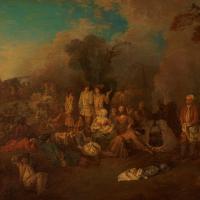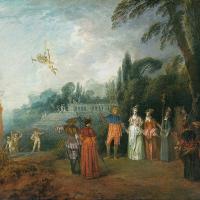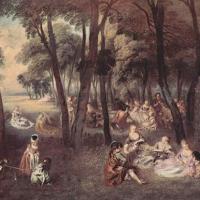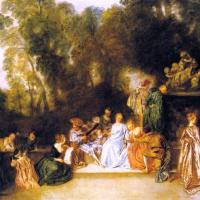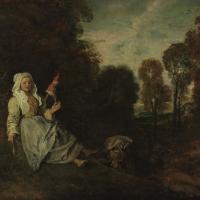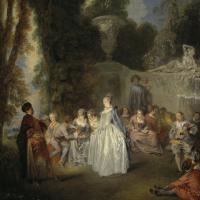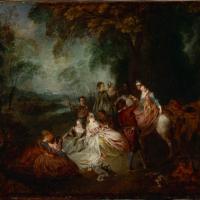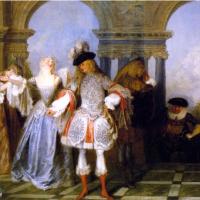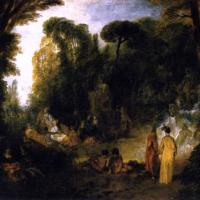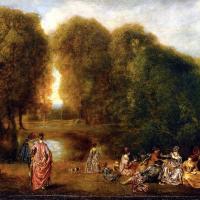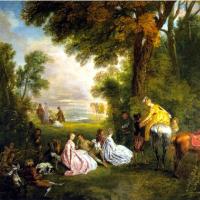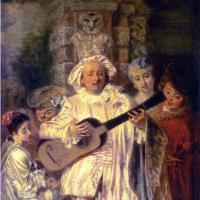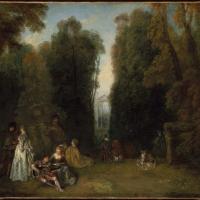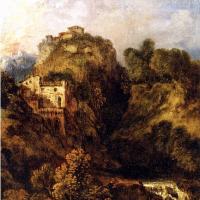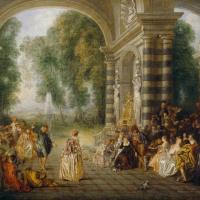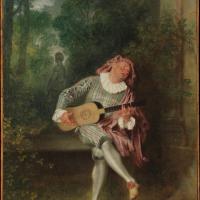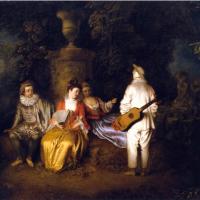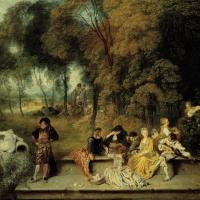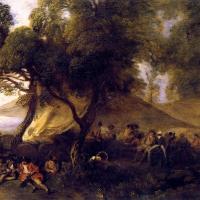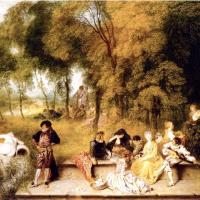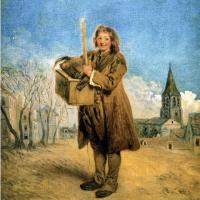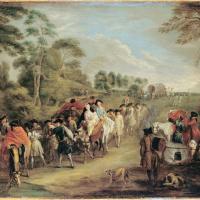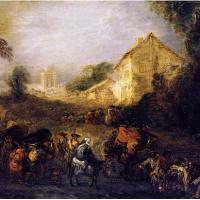Antoine Watteau (1684-1721)
Jean-Antoine Watteau (baptised October 10, 1684 – died July 18, 1721), better known as Antoine Watteau, was a French painter whose brief career spurred the revival of interest in colour and movement, as seen in the tradition of Correggio and Rubens. He revitalized the waning Baroque style, shifting it to the less severe, more naturalistic, less formally classical, Rococo. Watteau is credited with inventing the genre of fêtes galantes, scenes of bucolic and idyllic charm, suffused with a theatrical air. Some of his best known subjects were drawn from the world of Italian comedy and ballet.
Watteau was born in October 1684 in the town of Valenciennes which had recently passed from the Spanish Netherlands to France. His father, Jean-Philippe Watteau, was a roofer given to brawling. Showing an early interest in painting, Jean-Antoine may have been apprenticed to Jacques-Albert Gérin, a local painter. Jean-Antoine's first artistic subjects were charlatans selling quack remedies on the streets of Valenciennes. Watteau left for Paris in 1702. There he found employment in a workshop at Pont Notre-Dame, making copies of popular genre paintings in the Flemish and Dutch tradition; it was in that period that he developed his characteristic sketchlike technique.
By 1705 he was employed as an assistant by the painter Claude Gillot, whose work represented a reaction against the turgid official art of Louis XIV's reign. In Gillot's studio Watteau became acquainted with the characters of the commedia dell'arte (its actors had been expelled from France in 1697), a favorite subject of Gillot's that would become one of Watteau's lifelong passions.
Afterward he moved to the workshop of Claude Audran III, an interior decorator, under whose influence he began to make drawings admired for their consummate elegance. Audran was the curator of the Palais du Luxembourg, where Watteau was able to see the magnificent series of canvases painted by Peter Paul Rubens for Queen Marie de Medici. The Flemish painter would become one of his major influences, together with the Venetian masters he would later study in the collection of his patron and friend, the banker Pierre Crozat.
In 1709 Watteau tried to obtain the Prix de Rome and was rejected by the Academy. In 1712 he tried again and was considered so good that, rather than receiving the one-year stay in Rome for which he had applied, he was accepted as a full member of the Academy. He took five years to deliver the required "reception piece", but it was one of his masterpieces: the Pilgrimage to Cythera, also called the Embarkation for Cythera.
Watteau lacked aristocratic patrons; his buyers were bourgeois such as bankers and dealers. Among his most famous paintings, beside the two versions of the Pilgrimage to Cythera, one in the Louvre, the other in the Schloss Charlottenburg, Berlin, are Pierrot (long identified as "Gilles"), Fêtes venitiennes, Love in the Italian Theater, Love in the French Theater, "Voulez-vous triompher des belles?" and Mezzetin. The subject of his hallmark painting, Pierrot (Gilles), is an actor in a white satin costume who stands isolated from his four companions, staring ahead with an enigmatic expression on his face.
Watteau's final masterpiece, the Shop-sign of Gersaint, exits the pastoral forest locale for a mundane urban set of encounters. Painted at Watteau's own insistence, "in eight days, working only in the mornings ... in order to warm up his fingers", this sign for the shop in Paris of the paintings dealer Edme François Gersaint is effectively the final curtain of Watteau's theatre. It has been compared with Las Meninas as a meditation on art and illusion. The scene is an art gallery where the façade has magically vanished, and the gallery and street in the canvas are fused into one contiguous drama.
Watteau alarmed his friends by a carelessness about his future and financial security, as if foreseeing he would not live for long. In fact he had been sickly and physically fragile since childhood. In 1720, he travelled to London, England, to consult Dr. Richard Mead, one of the most fashionable physicians of his time and an admirer of Watteau's work. However, London's damp and smoky air offset any benefits of Dr. Mead's wholesome food and medicines. Watteau returned to France and spent his last few months on the estate of his patron, Abbé Haranger, where he died in 1721, perhaps from tuberculous laryngitis, at the age of 36. The Abbé said Watteau was semi-conscious and mute during his final days, clutching a paint brush and painting imaginary paintings in the air.
His nephew, Louis Joseph Watteau, son of Antoine's brother Noël Joseph Watteau (1689–1756), and grand nephew, François-Louis-Joseph Watteau, son of Louis, followed Antoine into painting.
Little known during his lifetime beyond a small circle of his devotees, Watteau "was mentioned but seldom in contemporary art criticism and then usually reprovingly". Sir Michael Levey once noted that Watteau "created, unwittingly, the concept of the individualistic artist loyal to himself, and himself alone". If his immediate followers, Lancret and Pater, would depict the unabashed frillery of aristocratic romantic pursuits, Watteau in a few masterpieces anticipates an art about art, the world of art as seen through the eyes of an artist. In contrast to the Rococo whimsicality and licentiousness cultivated by Boucher and Fragonard in the later part of Louis XV's reign, Watteau's theatrical panache is usually tinged with a note of sympathy, wistfulness, and sadness at the transience of love and other earthly delights. Famously, the Victorian essayist Walter Paterwrote of Watteau: "He was always a seeker after something in the world, that is there in no satisfying measure, or not at all."
Watteau was a prolific draftsman. His drawings, typically executed in trois crayons technique, were collected and admired even by those, such as Caylus or Gersaint, who found fault with his paintings. In 1726 and 1728, Jean de Jullienne published suites of etchings after Watteau's drawings, and in 1735 he published a series of engravings after his paintings, The Recueil Jullienne. The quality of the reproductions, using a mixture of engraving and etching following the practice of the Rubens engravers, varied according to the skill of the people employed by Jullienne, but was often very high. Such a comprehensive record was hitherto unparalleled. This helped disseminate his influence round Europe and into the decorative arts.
Watteau's influence on the arts (not only painting, but the decorative arts, costume, film, poetry, music) was more extensive than that of almost any other 18th-century artist. The Watteau dress, a long, sacklike dress with loose pleats hanging from the shoulder at the back, similar to those worn by many of the women in his paintings, is named after him. According to the 1911 Britannica, "in his treatment of the landscape background and of the atmospheric surroundings of the figures can be found the germs of Impressionism". His influence on later generations of painters may have been less apparent in France than in England, where J.M.W. Turner was among his admirers. A revived vogue for Watteau began in England during the British Regency, and was later encapsulated by the Goncourt brothers and the World of Art.
In 1984 Watteau societies were created in Paris, by Jean Ferré, and London, by Dr. Selby Whittingham. A major exhibition in Paris, Washington and Berlin commemorated the 1984 tercentenary of his birth. Since 2000 a Watteau centre has been established at Valenciennes by Professor Chris Rauseo. A catalogue of his drawings has been compiled by Pierre Rosenberg, replacing the one by Sir Karl Parker, and Alan Wintermute is preparing one for his paintings.


